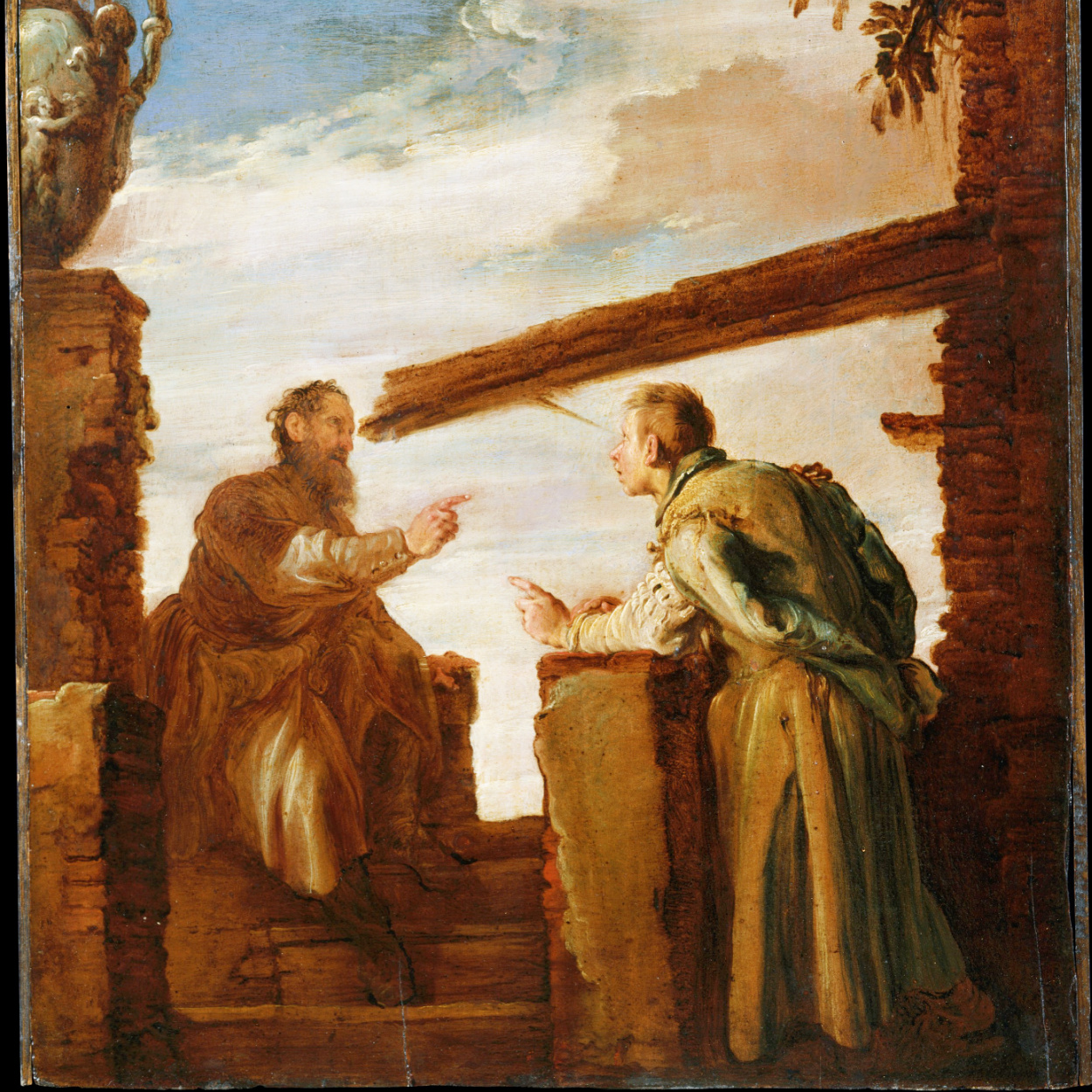As is well known, endowed members of The Church of Jesus Christ of Latter-day Saints wear a sacred undergarment which, among other things, serves as a reminder of the commitments they made to God in the Holy Temple. By covenant or sacred promise, they wear this symbolic article of clothing night and day, with the exception of when engaging in “activities that [cannot] reasonably be done while wearing the garment.” During the process of receiving one’s endowment, the patron is reminded that he or she is entering into covenants “of their own free will and choice” and not by constraint. Nonetheless, implied is the clear assumption is that, if one chooses to enter sacred temple covenants, it is his or her intent to strive to keep those covenants, including the promise to wear the holy garment.
Sacred Symbols
There is a measure of duality associated with the garment and what it is commonly understood to represent. The alternate interpretations are not at odds with each other but, rather, are two sides of the same proverbial “coin.” They are complementary symbols, each rooted in the truth that the temple is entirely Christocentric.
The most obvious interpretation of the garment’s symbolic meaning is that it represents Jesus. Because the Hebrew word for “atonement” (kpr or kaphar) means to “cover,” just as the garment “covers” our flesh, Christ “covers” or pays for the sins of those who sincerely repent. In our failings, He is there to “cover” our shortcomings and redeem us from our “fallenness.” Thus, we wear the garment as a constant reminder of our covenants and, more particularly, of Jesus’ willingness to aid the sincere practitioner in keeping those covenants. The message of the garment is both doctrinal and hope-filled.
The combination of these two related symbols—the garment as the atoning flesh of Christ and the glory we seek to regain—creates a composite picture that emphasizes to the wearer that our nature here is fallen but that something higher awaits us, even a glory beyond our current comprehension. The garment also reminds us that the achievement of that glory can come (1) only through the aid of Christ and His sacrifice on our behalf, and (2) only as we “conform” our lives “to the image of Christ.” Thus, the garment is rightfully seen as a symbol of our fallenness, our redemption, our return to glory, our eventual resurrection, and even our divine nature. There could hardly be a more important symbol for us to understand, as the message of the garment is both doctrinal and hope-filled.
Miracles, Modesty & Meaning
Among those outside of the Church, and some members of the Church as well, a persistent tradition exists. Essentially, it is the claim that the temple garment has some kind of almost “magical power” to “protect” the wearer from danger or death. While I have no doubt that some have had miraculous experiences of physical protection while wearing the garment, that seems to miss the primary point of this sacred article of clothing and its “power to protect.”
The main form of protection offered by the temple garment seems to be spiritual. Because it is intended to be a reminder of one’s covenants and of Christ, it can “protect” the wearer by keeping him or her out of spiritual danger. The modesty inherent in the garment increases the likelihood that the endowed member will treat his or her body as a temple. If the symbolic meaning of the garment is understood and pondered, the likelihood of committing some act of serious sin is reduced. When worn with intent, one is more likely to keep his or her covenants and less likely to be found in places contrary to those oaths or fraternizing with those who would break or mock them. The sacred garment “protects” us by keeping us out of spiritual danger and limiting Satan’s power over us, all the while promoting personal righteousness and the development of Christlike attributes.

One other point about the “power” of the garment is worth noting. The prolific Jewish scholar Jacob Neusner pointed out that symbols only have power if we endow them with meaning. If a CTR (“choose the right”) ring is not endowed with meaning, it’s just jewelry. If the bread and water of the Sacrament are not endowed with meaning, they’re just bland food. If the temple garment is not endowed with meaning, it is just underwear. Thus, for any symbol to have power and impact, we must assign it some symbolic meaning, and then we must think about that meaning when we interact with the symbol. Otherwise, it will have no power to “protect” or inspire the wearer.
Commonality, Complacency, & Consequences
Temple garments have always been a source of misunderstanding and derision. What people do not understand, they commonly mock. The sacred symbolism behind the LDS temple garment is no exception. Though some perceive it as “odd,” if not outright “cultish,” what’s important to realize is that many of the world’s major religions have utilized sacred liturgical clothing as a reminder of the obligations the wearer has to his or her God.
Additionally, sacred “undergarments” are not a uniquely LDS concept. For example, the priests of the ancient Jewish temple wore “linen breeches” and a “shirt” beneath their other liturgical vestments. Similarly, modern Orthodox Jewish men traditionally wear an undergarment called the tallit katan—a small poncho-like shirt that has on its four corners twisted and knotted tassels called ẓiẓit (or tzitzit), meaning “fringes.” (See Deuteronomy 12:12 & Numbers 15:37-41.) Symbols only have power if we endow them with meaning.
In the Sikh tradition, there are five “Ks,” or five articles of clothing worn by baptized members. One of those five items is the kach (or kachera), a baggy pair of white underpants with a drawstring, which symbolically stresses the need to have “moral strength” and to live a chaste life.
Though these are not the only religions to have some form of sacred undergarments, the examples described evidence the commonality of this practice. While the donning of sacral “underwear” may seem strange to most Westerners, this ritual behavior is ancient in origin and very prevalent. For those who participate in wearing emblematical undergarments, these can have unique and significant power in their lives and efforts at developing personal spirituality.
Though much of the derision regarding the Latter-day Saint temple garment has understandably come from those outside the faith, in recent years, there has been a noticeable trend among some members within to challenge the need for temple garments and to discount the promise they made in the temple to wear them. Curiously, Jesus shared a parable that may have some bearing on this recent trend. In the twenty-second chapter of Matthew, we find “The Marriage of the King’s Son.” The last four verses of this symbolic story are significant for our discussion here. We read:
And when the king came in to see the guests, he saw there a man which had not on a wedding garment: And he saith unto him, ‘Friend, how camest thou in hither not having a wedding garment?’ And [the man] was speechless. Then said the king to the servants, ‘Bind him hand and foot, and take him away, and cast him into outer darkness; there shall be weeping and gnashing of teeth. For many are called, but few are chosen.’
There is no support for seeing the “garment” in this parable as the equivalent of the temple garment received in the holy endowment. Nonetheless, Jesus’ teachings in these verses actually do have a bearing on the sacred clothing received during the Church’s “higher ordinances.”
In his commentary on this parable, the Swiss theologian Ulrich Luz explained, “The guests were invited to come straight from the highways to a meal that was already prepared and waiting. Even if they are not beggars, in these circumstances, one could not expect them to appear in special clothing … Thus, the strange ‘wedding garment’ invites the readers to interpret the parable metaphorically.” Professor Luz then asks, “What is the meaning of the remarkable ‘wedding garment’? … The wedding garment corresponds to the obedience to the ‘will of the father’” expected from those who profess to be believers.
Similarly, New Testament Scholar R.T. France wrote: Saint Augustine’s “suggestion that the host [of the wedding] provided special garments … was prompted by the question [of] how a man just brought in from the street could have had [the] opportunity to go home and change; but this is simply another feature where the parable departs from real-life probability in order to draw out a lesson. The lesson is that, though entry to God’s salvation is free for all”—through the Atonement of Jesus Christ—“it is not therefore without standards, [nor] to be taken lightly.” The host, representative of God, sets the “standard”; not the “guest” whom He has invited into His house. We who wish affiliation with God, Christ, and their Church must do so on their terms.
Each of our commentators on these verses sees the same message in this parable. The Father has commanded those who seek to be in a “marriage” (or “covenant relationship”) with Him to do so on His terms. Just as the “wedding guest” was “cast out” for coming on his own terms, the parable reminds us that we who wish affiliation with God, Christ, and their Church must do so on their terms; not our own.
Related to this idea is a passage from the book of Exodus in which Jehovah commands: “If you use stones to make an altar for me, don’t use stones that you have shaped with tools. When you use … tools on the stones, you make them unsuitable for use in worship” (Exodus 20:25 NCV). Symbolically, God is saying that the stones from which the altar is to be made symbolize the commandments, covenants, and sacrifices to be enacted atop the altar. To “shape” or “chisel” away at those stones represents trying to change or modify the covenants or commandments to suit our own needs or wants. The prophet Isaiah famously warned that some “have transgressed the laws, changed the ordinance[s], [and] broken the everlasting covenant.” It is not for us to change what God has given, revealed, or commanded—in the temple or elsewhere. So much of becoming like God is being submissive to God—and to those whom He has sent to reveal His will and ways. Once endowed in the Holy Temple, wearing the garment as commanded and as promised is an act of submission to God, and one we are not authorized to “alter” or “change,” even if the garment is largely symbolic.

Emphasis and Change
In the April 2024 general conference, President Dallin H. Oaks spoke of our covenant, once endowed, “to wear [the] temple garment … continuously” because “covenants do not ‘take a day off.’” He added, “to remove one’s garments can be understood as a disclaimer” or rejection “of the covenant responsibilities and blessings to which they relate.” Similarly, in that same conference, Sister J. Anette Dennis of the Relief Society General Presidency taught that wearing the garment “is both a sacred obligation and a sacred privilege … [My] willingness to wear the holy garment becomes my symbol to Him. It is my own personal sign to God, not a sign to others.” Hence, we wear the garment underneath our outer clothing, where no one but God can see it.
Finally, in the April 2024 general conference of the Church, President Emily Belle Freeman, Young Women General President, said: “I listened … closely to the conversations around me regarding covenants. I noticed people asking, Why should I walk a covenant path? Do I need to enter a house for making covenants? Why do I wear the holy garment? Should I invest in a covenant relationship with the Lord? The answer to these good and important questions is simple: it depends on what degree of relationship you want to experience with Jesus Christ.” As with all covenants, Jesus sets the conditions, not us. And, like the man in the parable who refused to wear the garment he was obligated to wear, we, too, forfeit certain blessings by disobeying the God-given conditions of the covenant. As with all covenants, Jesus sets the conditions, not us.
Do you keep the covenants that you made in the temple?
Do you honor your sacred privilege to wear the garment as instructed in the initiatory ordinances?
The garment of the holy priesthood reminds us of the veil in the temple, and that veil is symbolic of Jesus Christ. When you put on your garment, you put on a sacred symbol of Jesus Christ. Wearing it is an outward expression of your inner commitment to follow Him. The garment is also a reminder of your temple covenants. You should wear the garment day and night throughout your life. When it must be removed for activities that cannot reasonably be done while wearing the garment, seek to restore it as soon as possible. As you keep your covenants, including the sacred privilege to wear the garment as instructed in the initiatory ordinances, you will have greater access to the Savior’s mercy, protection, strength, and power.
The numerous statements in general conference about wearing the garment and the updated temple recommend questions suggest that those who direct this work are concerned. This “trend” to only occasionally wear the garment, or to outright reject wearing it, has apparently caused the leaders of the Church to give this sacred obligation additional emphasis, encouraging members to be Saints who keep their promises as well as men and women who reap the blessings promised when faithful to their covenants.
Conclusion
Nothing shared herein is intended as a criticism of those who, once endowed, have struggled to keep their covenant to wear the sacred garment. Rather, all that has been said is intended to invite readers to contemplate what the garment really is and what it is designed to accomplish. While it is not “magic,” it does serve to facilitate our ultimate goal, which is to become like God and Christ and to develop “the image of God” in “our countenances.” Faithfully wearing the garment and endowing it with symbolic meaning will help the wearer to:
- Be more respectful of their physical body and its sacred purposes in God’s plan.
- Be more conscious of the need to rely on Christ’s atonement.
- Be more aware of Christ’s willingness to “cover” our day-to-day failings.
- Be more inclined to Christian behaviors and the development of Christian attributes.
- Be more hopeful about the promise of a glorious resurrection.
- Be more “one” with Christ, through Whom all good things are possible.
I am not implying that the sacrifice and obedience necessary to keep covenants—including temple covenants—is easy. Doing so requires effort and often pushes one outside of what’s comfortable or convenient. And yet, as President Jeffrey R. Holland explained, “the gospel is [designed] ‘to comfort the afflicted and to afflict the comfortable.’” And in his talk, “The Inconvenient Messiah,” he pointed out that “discipleship” always comes with demands. “Satan counters such discipline with temptations of an easier way, with an offer of ‘convenient Christianity.’ It is a temptation Jesus resisted, and so must we.”
Yes, wearing the “garment of the holy priesthood” is going to be “inconvenient” or challenging for some. And yet, it is through such “inconveniences” that we ultimately imitate the life and example of our Savior; and through such acts that we develop the submissive nature that is requisite for those who hope to become as God is.
I conclude by reiterating one of the new Temple Recommend questions, which asks: “Do you honor your sacred privilege to wear the garment?” Implicit in this statement is the truth that we should hold in high regard (i.e., “honor”) the generous blessing (i.e., “privilege”) God has granted us to have restored priesthood keys, a proliferation of Temples in which those keys operate, and protective covenants and symbols received therein. You may not see the “whys” behind wearing the garment, but that is less important than the act of obedience to God and covenants—something each of us can grasp.
To paraphrase something President Russell M. Nelson recently said, “If you don’t yet love to [wear] the temple [garment], [wear it] more often—not less … I promise you that over time, the temple [garment] will become a [source] of safety” to you. Of course, that “safety” and potential “power” will only come if we wear the garment contemplatively and with intent. President Nelson rightfully testified: “Whenever any kind of upheaval occurs in your life, the safest place to be spiritually is living inside your temple covenants!” And a major part of “living inside [our] temple covenants” is faithfully wearing our temple garment, as we promised the Lord we would.
















